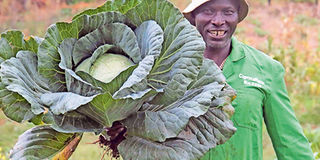Agronomist notebook: All about ring spot disease in cabbages

Samuel Mureithi displays a cabbage in his farm in Nyeri County. Cabbages do well in well-drained sandy or silty loam soils with high organic matter content and pH of 6.0 – 6.5. PHOTO | JOSEPH KANYI | NATION MEDIA GROUP
What you need to know:
- The plant’s leaves had yellow patches, some with circular brown-grey spots surrounded by a green margin and others with black-specked concentric zones.
- It is a fungal disease that is common and severe during wet weather. The fungus causes light -brown to grey spots on the leaves surrounded by a yellow halo.
- In seed stalks, the fungus causes a distortion. Dark lesions may develop on stored cabbage and may penetrate deeply affecting the shelf-life.
- Severe ring spots on leaves can reduce growth, delaying harvest and damaging crops that are harvested in leaf
Many farmers have embraced measures to curb the spread of Covid-19 on their farms by installing hand-washing points to enhance sanitation.
On Samsom’s farm in Kajiado County, where he grows cabbages, beside the hand-washing points, he offers workers masks and enforces social distancing.
But even as he helps fight the spread of Covid-19, he also has to grapple with crop pests and diseases, thanks to the heavy rains.
I visited his farm last week when he asked for my help after a disease attacked his cabbages.
The plant’s leaves had yellow patches, some with circular brown-grey spots surrounded by a green margin and others with black-specked concentric zones.
These are symptoms of ring spot disease that affects members of the brassica family such as sukuma wiki (collard greens), cabbages and cauliflower.
It is a fungal disease that is common and severe during wet weather. The fungus causes light -brown to grey spots on the leaves surrounded by a yellow halo.
With time, tiny black fruiting bodies containing large numbers of spores develop in concentric circles in the centre of the spots, which give the disease the name ring spot.
Ring spot affects young seedlings and it is more severe in mature and old plants. Too many spots on the leaves join together, resulting in the leaves turning yellow and dying early. The ring spot lesions are grey and contain black, pinheaded dots in concentric circles.
In seed stalks, the fungus causes a distortion. Dark lesions may develop on stored cabbage and may penetrate deeply affecting the shelf-life.
The fungal infection development is favoured by cool moist conditions. It’s easily spread by wind, water splashes and compost made from infected crop remains. The disease can be spread in distant places through the movement of seeds or seedlings.
BREAKING THE DISEASE'S CYCLE
All the above ground portions of the plant may show symptoms. The disease results in the early death of the leaves, spreading through the different layers of the plant.
Severe ring spots on leaves can reduce growth, delaying harvest and damaging crops that are harvested in leaf. Avoid storing affected cabbages as the fungus spreads deep into the leaves.
To ensure the disease is managed, one should establish the nurseries as far as possible from the affected fields and the trays should be clean and disinfected. Always go for certified seeds that are resistant to the disease.
In the nursery, scout for the affected seedlings and remove those with infected leaves. If severely infected, destroy the seedlings to avoid transferring the disease to the field.
Avoid planting overlapping crops of the brassica family and if you do, plant the younger crop far away from older ones to prevent the spread of the disease.
Weeds should be removed as they act as an alternate host to the disease. Do crop rotation to help in breaking the disease life cycle.
Sanitise all the tools on the farm regularly to avoid the spread of the disease. The disease is spread by wind hence the need to plant border crops that acts as windbreakers.
Consider the source of manure as the use of compost made from infected material may be a source of the pathogen to the crop. You can use various chemicals readily available in agrovets to control the disease.
Cabbages do well in well-drained sandy or silty loam soils with high organic matter content and pH of 6.0 – 6.5.
Thus, ensure the soil is well-drained as waterlogged ones makes the cabbage plant wilt and eventually rot resulting in yields reduction.


